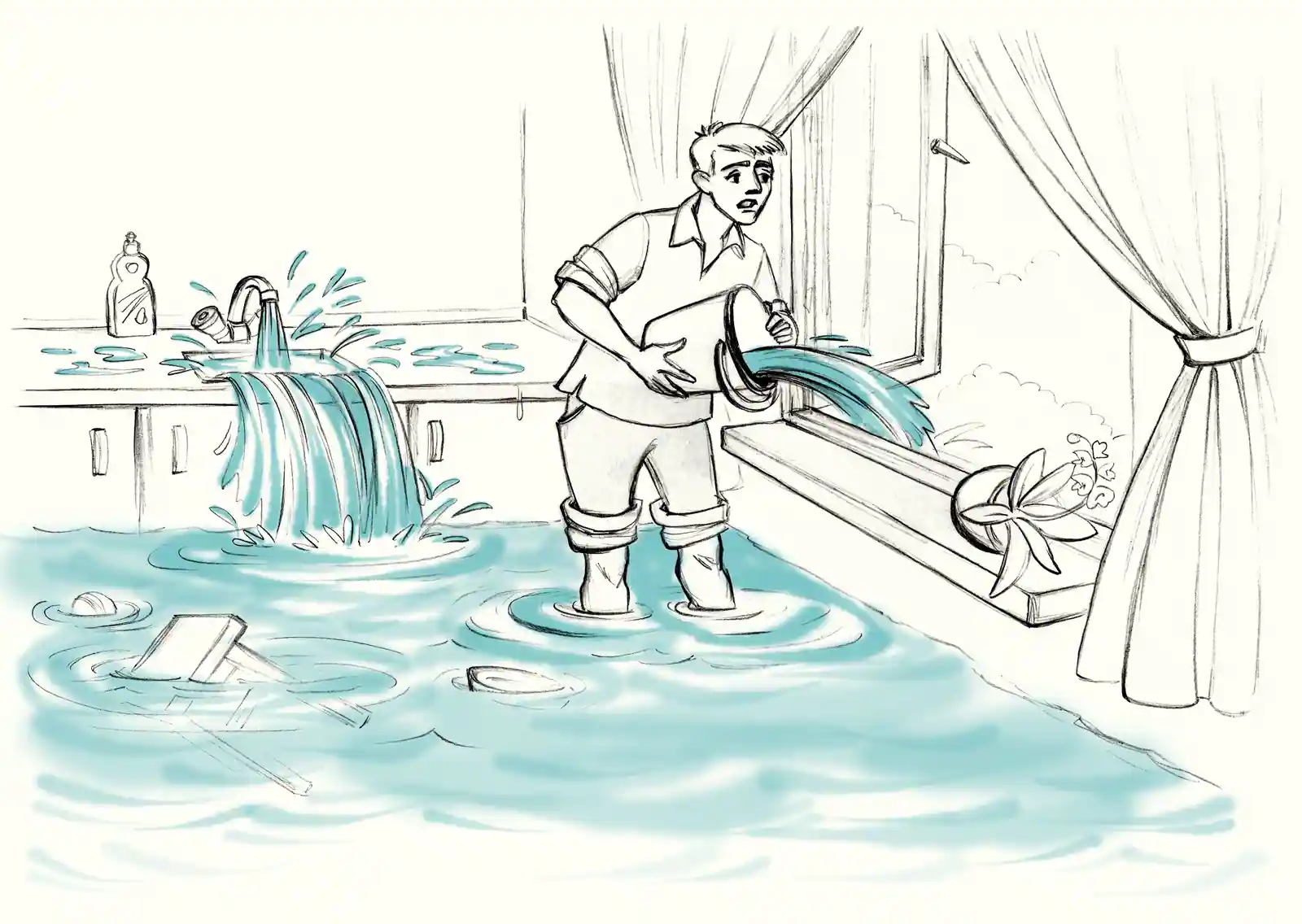You look at your life, and on the surface, it seems you’ve done everything right. You’re the innovator or the high-performer the successful entrepreneur or the "gifted" student who always excelled. You've built a career, a business, or a reputation on being capable, driven, and resilient.
Then, one day, you find you’re not.
Suddenly, the simple admin of life becomes an impossible mountain to climb. You’re missing deadlines you would have once found trivial. You feel overwhelmed, anxious, or perhaps even depressed. You might be struggling with poor sleep self-medicating to switch off, or finding yourself in conflicts you don't understand. You look at your past success and your current struggle, and the two pictures just don't align.
You might be told it’s "burnout," "anxiety," or a "mid-life crisis." And while those things may be present, they are often the symptoms, not the root cause.
This is understandable, since often the symptoms and outcomes are seen first, rather than the root cause. For many successful adults, this "crash" is the first time they are truly meeting their undiagnosed, unmanaged Attention Deficit Hyperactivity Disorder (ADHD).
Why has it taken this long to show? The truth is, for your entire life, you’ve likely been supported by a complex, often invisible, system of "scaffolding."
And that scaffolding has just been kicked away.
At ADHD Specialist, we believe in looking beyond just the label. Our comprehensive, 2.5-hour assessments are designed for complex individuals like you—to understand your strengths, your weaknesses, your journey, and most importantly, your goals.
Today, we will discuss the importance of scaffolding in ADHD, why its collapse can be so devastating for high-achievers, and how a thorough, comprehensive assessment is the way to build a more sustainable foundation for your future.

What is 'Scaffolding' in the Context of ADHD?
So, what is this "scaffolding" I'm talking about?
In simple terms, it's the unseen support system. It's all the people, the routines, the environments, and the structures that work together to make a person with ADHD successful. This scaffolding is what keeps them on track, filters out the world's endless distractions, and mitigates the risks that could get them into serious trouble.
This support system may or may not ever receive the credit it deserves. Often, it's completely invisible—even to the very person it's supporting. It's the partner who handles the bills, the assistant who manages the diary, the rigid structure of school, or the quiet-by-design home office. It just... works.
But make no mistake: without it, everything can fall apart.
Let me be very clear: the need for this scaffolding is not about a lack of intelligence or willpower. This is a point I must stress. Many of the people I see are brilliant. The challenge is a real, neurobiological difference in the brain's 'management system'—what we call executive functioning.
This system is the part of your brain that is supposed to handle the mundane but critical tasks of life. It's what allows you to organise and plan, to manage your time, to regulate your emotional responses, and to hold information in your mind. Crucially, it's what gives you the ability to start a task, especially if it's boring or overwhelming. It’s the part of the brain that deals with the admin, not the big, exciting ideas.
For a person with high intelligence or a powerful drive, these underlying deficits can be masked for decades. They use their strengths to compensate, pushing through. The "scaffolding" is what has been bridging the gap between their brilliant, innovative ideas and the mundane, administrative execution required to make them happen.
When that scaffolding is strong, you function at a high level. When it weakens or is removed, the entire structure can feel like it's collapsing.

A Note on Scaffolding: Bungalows vs. The Shard
It's also crucial to understand that not all scaffolding is the same.
You need one type of scaffolding to build a bungalow. You need a much more complex, robust scaffolding to build a multi-story stately home. And you need an entirely different, highly engineered scaffolding to build The Shard.
The same is true for your life. The support system needed for a simple, predictable job is different from the one needed to run a 10,000-employee company, raise three children, and manage a complex social life.
The higher the demands of your life (the 'taller' your building), the more robust your scaffolding needs to be. Often, high-achievers have been building "The Shard" of their life with "bungalow" scaffolding, held together by sheer willpower, adrenaline, and the support of others. When that support is removed, the risk of collapse is significant.

Case Studies in Collapse: Four Scenarios Where Scaffolding Falls
Let me give you a few scenarios. These are composites of the kinds of high-performing individuals we see at our clinic every day. Many people can live their entire life with ADHD, or until certain stages, without ever knowing. See if any of these sound familiar.
Scenario 1: The Visionary Entrepreneur
The Individual: A classic innovator. This is the successful business person, the "big picture" thinker. They thrive on the chaos of new ventures, joining and exciting new projects quickly, effectively, and at a profit. They can sell an idea, build excitement, and work 18-hour days fuelled by adrenaline. They've built a company with 1,000, 5,000, or even 10,000+ employees. They are literally changing the world.
The Scaffolding:
- A "Team": A highly competent team of personal assistants (PAs) who manage their diary, book their travel, handle their emails, and anticipate their needs.
- A "Detail Person": A CFO, COO, or business partner who handles the "boring" parts—the spreadsheets, the legal compliance, the HR policies, the day-to-day operations.
- A "Novelty-Rich" Environment: The constant "putting out fires" and a stream of new, exciting projects keeps their dopamine-seeking brain fully engaged.
- A Supportive Home: A partner who runs the household, manages the children's schedules, and ensures life outside of work is stable.
The Collapse: So how come a successful entrepreneur, changing the world, is suddenly struggling? The "crash" doesn't happen in one go. It’s a perfect storm on a background of long-term struggles mitigated by this solid scaffolding.
- Loss of Support: Two of their long-term, "mind-reading" PAs leave in quick succession. The new hires are competent but require training and direction—direction the entrepreneur struggles to give.
- Increased Stress: Then, one of their own children receives a diagnosis. This news acts as an emotional mirror, forcing the entrepreneur to see their own lifelong struggles in a completely new light.
- Loss of Novelty: The business has matured. It's no longer about "the next big thing" but about "quarterly reports" and "incremental improvements." The entrepreneur is bored, restless, and can't find the motivation.
Suddenly, they are dropping balls everywhere. They feel anxious, overwhelmed, and are self-medicating with alcohol to stay asleep. They try to recreate their past success by replicating the same model, but they can't. It's not a lack of talent; it's the loss of the administrative and domestic scaffolding that allowed their talent to shine.

Scenario 2: The "Gifted" Student
The Individual: This is one of the most common cases. A bright, articulate, and "gifted" student who always did well in primary school, and to some extent, in secondary school. They were in the top sets, got excellent grades, and were the pride of the family.
The Scaffolding:
- A "Project Manager" Parent: On deeper investigation, we often find one parent gave up or scaled back their own career to manage the student's life. They provided that scaffolding: packing their bag, reminding them of homework, scheduling revision, proofreading essays, and handling all communication with the school.
- A Team of Tutors: The family has the resources to provide extensive support. What looks like "effortless" success is often the product of 4-5 different private tutors through their education.
- A Structured Environment: The highly regulated, teacher-led environment of school provides a rigid external structure that keeps them on track. In some cases, a parent may even be a teacher at the school, providing yet more support.
The Collapse: The A-levels. Or, more commonly, the first term of university. The student moves away from home for the first time. The parental scaffolding is gone. The private tutors are gone. The rigid school structure is replaced by the "freedom" of university life.
For the first time in their life, they are solely responsible for managing their time, their laundry, their food, and their education. They can't start their essays. They sleep through lectures. They find themselves paralysed, unable to even begin, and fall into a cycle of procrastination, guilt, and anxiety. Their family is baffled. "You're so bright!" they say. "It's normal to underperform when you go to university" or "You're just being lazy."
It's not about being lazy. It’s the sudden, terrifying absence of a support system they never even knew existed, revealing a potential underlying neurodevelopmental condition.

Scenario 3: The "Curated" Professional
The Individual: A highly skilled professional—a lawyer, a programmer, a designer, an analyst. They are known for their meticulous work, their creativity, and their high productivity.
The Scaffolding:
- The Perfect Home Office: The shift to remote work was a revelation. At home, they carefully mastered a perfect environment working for them.
- Environmental Control: A quiet room with no interruptions. Noise-cancelling headphones. The specific keyboard they like. Multiple monitors set up just so. The ability to "hyperfocus" for 4-hour stretches without anyone tapping them on the shoulder.
- Sensory Regulation: The ability to control the light, the temperature, and the sounds around them.
The Collapse: The "Return to Office" Mandate. Suddenly, this individual is back in an open-plan office. This professional, who was a top performer at home, is now struggling. The open-plan office is a sensory nightmare. The fluorescent lights hum. The constant chatter, the "quick questions" from colleagues—it's impossible to focus. They are "hot-desking," so their carefully curated setup is gone.
Their productivity plummets. They become irritable and anxious. They may even be "performance managed" by a boss who doesn't understand. "Nothing has changed with the job," the manager says, "so what's changed with you?"
Everything. The scaffolding—their controlled, quiet, predictable environment—has been taken away. The potential is still there, but their neurodevelopmental condition, perhaps unrecognised, is now unmitigated. The key aspect here is listening to this professional; they likely have an excellent track record. Learn from them. Maybe there are opportunities to implement their ideas throughout the organisation.

Scenario 4: The Unseen Partner
The Individual: A successful academic, surgeon, or artist. They are brilliant in their field, respected by their peers, and wholly dedicated to their "mission."
The Scaffolding:
- The "Domestic CEO": Their supportive partner. For 20, 30, or even 50+ years, this partner has been the unacknowledged scaffolding for their entire life.
- Life Administration: The partner takes care of cleaning, food shopping, daily house chores, admin chores, and all the mundane, repetitive tasks. They pay the bills, manage the investments, book the holidays, and remember the birthdays.
- Emotional Regulation: The partner is the "calm" one, the one who de-escalates, the one who soothes the professional's emotional volatility.
This unknown scaffolding, the partner, may be unrecognised by others for so many years. And don't get me wrong, these synergies can be created and can work very well for 50+ years, until the end.
The Collapse: This scaffolding is often only recognised and missed when it's not present anymore.
- Relationship Breakdown: The partner, feeling unrecognised, leaves.
- Illness or Old Age: The partner becomes ill, or simply through old age, can no longer manage the "life admin" for two people.
- Bereavement: The partner passes away.
The successful professional is suddenly faced with a mountain of tasks they have never had to do. They don't know how to use the online banking portal. They forget to eat. The house falls into disarray. Their carefully constructed world, and the professional success that depended on it, begins to crumble.

A Quick Word on Celebrities and Self-Diagnosis
We live in an age where ADHD is openly discussed on social media and in the news. People often look at certain celebrities telling their own stories, and it's easy to self-relate.
But it is very important to know one thing: their support system is not your support system.
When you hear a celebrity's story, please be aware of the limitations and the impulse to self-relate. Remember the scaffolding you don't see. Their support systems are likely very different from yours. They may have a PR Manager, a Family Office Manager, a CFO, a General Manager, and one or two personal PAs working 24/7 across different time zones.
They often have continuous support for their mental health, taking a proactive aspect rather than a reactive approach. Yes, their demands are also higher, but their scaffolding is built for a 'Shard' life, and it's built by a team of paid experts. It's a different world, and it's not a useful comparison when trying to understand your own daily struggles.

"But I'm Successful. How Can I Have ADHD?"
This is the big one. This is the single most common, and most important, question I hear from high-achievers. It can create a profound identity crisis.
Here’s why success and ADHD are not mutually exclusive:
- High IQ Can Mask ADHD: High intelligence is a powerful compensator. You can have a "weaker" working memory, but your high "processing speed" or "verbal reasoning" makes up for it. You "get away with it" for years, often at the cost of immense, invisible effort.
- Hyperfocus is a Superpower (Until It's Not): Many entrepreneurs and creatives are driven by hyperfocus. When you're interested in something, you have an infinite capacity for focus. This is what builds businesses. The problem is, you can't control it. You can hyperfocus on a new project for 72 hours, but you can't "make" yourself focus on a tax return for 20 minutes.
- Compensation & Masking: You are so used to "white-knuckling" your way through life that you assume everyone else finds it this hard, too. You've developed complex systems (e.g., 20 alarms, 5 to-do list apps) to appear organised. This is exhausting, and it's a key reason why high-achievers with undiagnosed ADHD are so prone to burnout.
- Inattentive ADHD: This form, often (but not exclusively) seen in women, doesn't present as "hyperactive." It presents as being "in a world of one's own," "daydreamy," or "forgetful." Because these individuals are not disruptive, they are overlooked. They are the "bright but underachieving" student who grows into an adult who feels they are constantly "failing to meet their potential."
Your success isn't despite your ADHD; in some ways, it's because of it (your creativity, drive, risk-taking). But the challenges of it have been successfully mitigated by your intelligence, your resources, and your scaffolding... until now.

The Dangers of a "Surface-Level" Diagnosis
When the "crash" happens, a high-performer's first instinct is to find a solution. Fast. This can be contradictory, as someone with ADHD might actually expect a quick fix.
This can lead them to seek help for the most obvious symptoms:
- "I feel anxious all the time." -> Anxiety Diagnosis
- "I feel flat and have no motivation." -> Depression Diagnosis
- "I'm exhausted and overwhelmed." -> Burnout Diagnosis
- "I'm drinking too much to cope." -> Substance Misuse
- "I can't stop gambling." -> Gambling Addiction
A professional who is not a specialist in adult ADHD and complex co-morbidities may treat these surface-level issues. They might recommend a quick fix or sign you off work.
This often fails.
Why? Because if the underlying, untreated ADHD is the engine driving the overwhelm, and the overwhelm is causing the anxiety, then treating the anxiety alone is like mopping the floor while the tap is still gushing. You are treating the outcome, not the cause.
This is why a comprehensive, 2.5-hour assessment is not a "nice-to-have"; it is an absolute necessity.

What a Comprehensive Assessment Should Be
I can't stress this enough: a professional ADHD assessment takes a long time to complete. We're talking more than two hours, sometimes even more. It must be conducted by an appropriately trained professional, ideally a Consultant Psychiatrist capable of dealing with all mental health conditions, not just ADHD.
A 15-minute "checklist", long pre-assessment tickboxes or an online-only test cannot possibly untangle the complex, decades-long interplay between your personality, your intelligence, your coping mechanisms, your anxiety, your mood, and your potential ADHD.
Now, it is very important to state that inattentive symptoms and hyperactivity are not all due to ADHD. Many other conditions can mimic these issues, including personality traits. The question is the duration of these symptoms, the number of symptoms, the impact on day-to-day functioning (at work, at home, in other settings), and that they are not better explained by other mental health or physical health conditions.
A clear answer can only be offered by having a comprehensive assessment. At ADHD Specialist, our process is a deep, investigative one.
- It Takes Time (2.5 Hours): This allows us to go beyond the surface. We explore your entire life history, from your early school days (even if you "did well") to your current professional and personal challenges.
- It Looks for Evidence: We gather objective information (if available). Such as school reports (which often contain clues like "chatty," "disorganised," or "bright but distractible") and, with your permission, input from a partner or family member.
- It Includes Differential Diagnosis: This is the most critical part. Are your inattentive symptoms due to ADHD, or are they due to depression? Is your restlessness due to anxiety, or is it ADHD-driven hyperactivity? Could it be a personality trait? Only a highly trained specialist can accurately differentiate.
- It's Holistic: This is the foundation for true, comprehensive care. We don't just ask about your problems. We want to understand the whole you—your strengths, your weaknesses, and most importantly, your goals. We look to understand you beyond just the label.
An assessment is not about "getting a label." It is about getting clarity.

Beyond the Diagnosis: Building Your New, Intentional Scaffolding
Remember the assessment it is just a starting point. It is important to start on solid ground.
This is crucial to understand, especially for the ADHD brain which often seeks that "quick fix." ADHD is a chronic condition. A diagnosis doesn't "cure" it. It gives you the blueprint and the instruction manual for your unique brain. The goal of treatment is to move from relying on accidental, unconscious, and overworked scaffolding (like a partner who does everything) to building purposeful, conscious, and sustainable scaffolding.
This holistic, comprehensive care plan—the one that eventually leads to sustainable, positive results for many years to come—may include:
- Psychoeducation: Simply understanding why your brain works the way it does is life-changing. It allows you to move from self-blame ("I'm lazy/stupid") to self-compassion ("My brain needs a different kind of support").
- Medication (If Appropriate): For many, medication is a powerful tool. It's not a "personality-changer." It's a tool that can "turn down the noise" and improve your baseline executive function, allowing you to use the strategies you're learning.
- Specialist ADHD Coaching or Therapy: This is where you build your new scaffolding. A coach can help you create systems for managing your life that work with your brain, not against it.
- Lifestyle & Environmental Changes: Now you can make conscious choices. You might hire a PA, not because you're "failing," but because you know your strength is in "big picture" thinking and you are strategically outsourcing your weakness. You might negotiate a hybrid work arrangement, knowing you need two quiet days at home to be productive.
This journey requires motivation and a significant emotional and financial investment. Each individual is unique. Mental health is often not a quick fix. Because ADHD it is often a chronic condition, it is essential long-term to consistently engage with your healthcare professional.

Take the First Step
If this article resonates with you, it may be time to seek clarity. An assessment is a profound act of self-care and a strategic investment in your future.
Are you based in London or the UK and looking for support for yourself or your child aged 16 or over? Book Your Comprehensive ADHD Assessment Today
References
7 ADHD Leadership Styles to Turn Your Symptoms into Strength
ADHD and Career Burnout: Causes, Signs & Recovery Tips
ADHD and Entrepreneurship: A Double-Edged Sword
ADHD & High-Achievers in London: The Private Path to Success
ADHD in A-Level Students: A Parent's Guide
Struggling First Year Uni? Could It Be Undiagnosed ADHD?
ADHD Symptoms in Women and Comorbid conditions
ADHD Specialist - Adult ADHD & Sleep Problems Treatment London
ADHD Specialist - Adult ADHD & Anxiety Assessment Treatment London
ADHD Specialist - Adult ADHD Symptoms & Diagnosis London & UK
Private ADHD Assessment London | Adults & Teens (16+) | UK
ADHD & Relationships: A Couples' Guide | ADHD Specialist
Mastering Time Management with ADHD (Tips & Techniques)
How ADHD Affects Relationships: Expert Tips for Success
ADHD Diagnosis: Likes, Swipes, and the Search for Clarity
Disclaimer: The information is not intended nor implied to be a substitute for professional medical advice, diagnosis or treatment. All content, and information, contained in this article is for general information purposes only and does not replace a consultation with your own doctor/health professional. Information about mental health topics and treatments can change rapidly and we cannot guarantee the content's currentness. For the most up-to-date information, please consult your doctor or qualified healthcare professional. For more information, you can check the Royal College of Psychiatrists (rcpsych.ac.uk)
Pictures source Pexels.com; Shutterstock.com Free Stock Photos, Royalty Free Stock Images & Copyright Free Pictures · Pexels ; Stock Images, Photos, Vectors, Video, and Music | Shutterstock
.svg)
.svg)





.svg)






